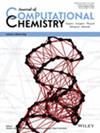Facile heterolytic bond splitting of molecular chlorine upon reactions with Lewis bases: Comparison with ICl and I2
IF 3.4
3区 化学
Q2 CHEMISTRY, MULTIDISCIPLINARY
引用次数: 0
Abstract
Formation of molecular complexes and subsequent heterolytic halogen‐halogen bond splitting upon reactions of molecular Cl分子氯与路易斯碱反应时容易发生异解键分裂:与 ICl 和 I2 的比较
在 M06-2X/def2-TZVPD、CCSD(T)/aug-cc-pvtz//CCSD/aug-cc-pvtz 理论水平下,对分子 Cl2 与含氮路易斯碱 (LB) 反应时分子配合物的形成及随后卤素-卤素键的异解分裂进行了计算研究。获得的结果与 ICl 和 I2 分子的数据进行了比较。反应路径表明,在 Cl2∙LB 复合物中,异解 Cl-Cl 键分裂的活化能低于 Cl2 分子同解分裂成氯自由基的活化能。在气相中,X2∙Py 分子络合物的异解卤素分裂形成[XPy2]+......接触离子对,在 Cl2 和 I2 的情况下是轻微的内热,而在 ICl 的情况下则是轻微的放热。{[ClPy2]+...}2二聚体的形成使整个过程放热。考虑到极性溶剂有利于离子物种的生成,在路易斯碱存在的情况下生成供体稳定的 Cl+ 预期是有利的。因此,在极性溶剂中,通过供体稳定的 Cl+ 物种进行氧化的途径是同解 Cl-Cl 键断裂的可行替代方法。
本文章由计算机程序翻译,如有差异,请以英文原文为准。
求助全文
约1分钟内获得全文
求助全文
来源期刊
CiteScore
6.60
自引率
3.30%
发文量
247
审稿时长
1.7 months
期刊介绍:
This distinguished journal publishes articles concerned with all aspects of computational chemistry: analytical, biological, inorganic, organic, physical, and materials. The Journal of Computational Chemistry presents original research, contemporary developments in theory and methodology, and state-of-the-art applications. Computational areas that are featured in the journal include ab initio and semiempirical quantum mechanics, density functional theory, molecular mechanics, molecular dynamics, statistical mechanics, cheminformatics, biomolecular structure prediction, molecular design, and bioinformatics.

 求助内容:
求助内容: 应助结果提醒方式:
应助结果提醒方式:


